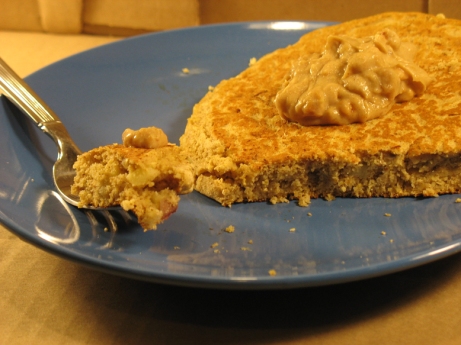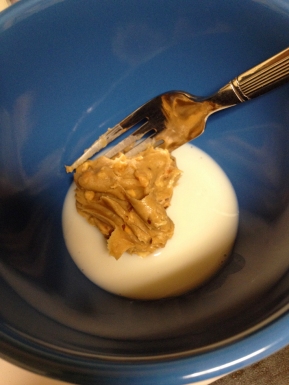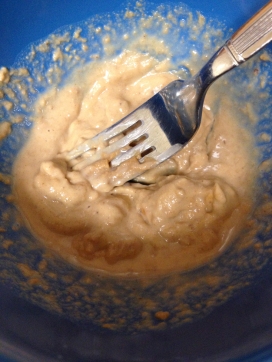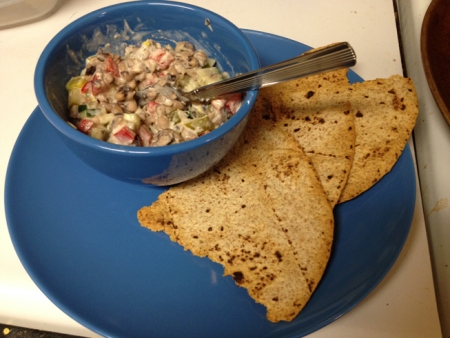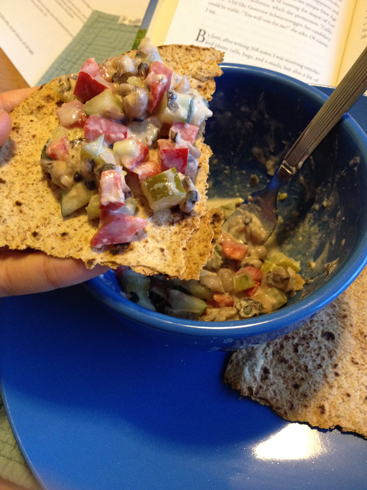Note: After some people expressed confusion, I’ve edited this post slightly to hopefully be clearer …. Hopefully it helps. good lesson in how to write these posts. Thanks for the feedback!
Being a non-meat eater, I’m a big fan of legumes. Lentils, chickpeas, black eyed peas, beans – I love them. But despite the fact that I will happily put in the extra time to make my own applesauce, bake my own bread, and prepare my own soup stock – I’m bizarrely lazy about beans and nearly always use canned. Lentils are the exception, because they take so little time to cook. But beans? Canned all the way.
To be honest, I think it’s the soaking part that holds me back. Do I really want to make an entire pound of dried beans at a go, even if I can freeze them? Do I really want to spend an entire day or even two preparing an ingredient for other dishes?
But since it happens to be the end of the month (aka low-on-my-grocery-budget week), and I happen to have a bag of dried black eyed peas that I bought in a fit of idealism some months ago, and I happen to be mildly obsessed with a black eyed pea salad I made up last week – I decided to make them.
At first I put them in water to soak, but my online directions claimed that it’s really optional. And since I then need to let them slow-cook for 6 – 8 hours, and it was already the middle of the day, I reversed course and dumped the bowl of beans into the slow cooker.
But I was left wondering: would soaking for just an hour be a bad thing? Would it help at all? Would it be irrelevant? How does this whole soaking-beans thing work? So I started Googling, and discovered the whole “soaking beans controversy.” People in the blogosphere don’t seem to agree on soaking beans at all.
Here’s what people DO agree on: soaking beans DOES help release indigestible complex sugars, known as oligosaccharides.
But some people argue that this isn’t the most important reason to soak the beans. They say that soaking the beans beforehand lets you cook them more quickly, thereby preserving more nutrients in the beans – and THAT’S why (so they say) you should soak your beans before cooking them.
Other people argue that beans are dirty and may pick up mold spores during the production process, so it’s important to soak and wash off your beans before cooking (ironically, anti-flatulance products are based in a type of mold enzyme that aids in the digestion of oligosaccharides).
So … I did a little layperson research.
How does soaking beans remove oligosaccharides?
Oligosaccharides are on the OUTSIDE of the beans. Oligosaccharides are water-soluble. This means that when you soak the beans, you dissolve the oligosaccharides in the water. This is why everyone stresses that you should toss the soaking water when you remove the soaked beans.
As far as the efficacy of soaking beans, a study published by NIH found that the “traditional household method” of preparing beans – soaking, rinsing, then boiling – did significantly remove oligosaccharides (up to 25%), but did NOT significantly impact the nutrients and minerals in the beans (source) – meaning that you’re still getting the nutritional benefits, minus some of the oligosaccharides, when you follow the soak/rinse/boil method.
Is removing oligosaccharides really important?
It turns out that oligosaccharides aren’t just in beans – one form of oligosaccharides, known as fructooligosaccharides, are in a lot of fruits and vegetables that we eat, and is used as an artificial sweetener in Japan. Another form, mannan oligosaccharides, is used in animal feed (Wikipedia).
It’s become well-accepted in the science community that the part of oligosaccharides that we can’t digest may serve a role similar to dietary fiber in our diets, such as improving how our body handles the consumption of glucose (sugars) and helping sustain healthy bacteria in our bodies. Because of this, some people want to add in oligosaccharides to processed foods. (source and source, both from NIH)
My conclusion:
So my conclusion? Wash your beans, but don’t soak them.
Whole Foods summarizes it this way on their website: if you’re susceptible to flatulance, then soaking away the oligosaccharides may be beneficial – but you’re sacrificing the benefits oligosaccharides offer to your body. To get the best of both worlds, eat a lot of beans so that your body gets used to consuming oligosaccharides (source). As for the benefits of longer vs. shorter cooking time, it’s more complicated than “yes vs. no,” so this is a question for another day.
If you’re susceptible to flatulence, you may want to do this as a slow and steady process, slowly adding more beans into your diet so that your body can adjust. You may also want to be alert to other foods that could be contributing, such as cabbage (another source of oligosaccharides) and dairy.
For those who insist on continuing to soak their beans…..
Okay, but I’m going to keep soaking beans for now. How long do you really need to soak them for? Does it make a difference what beans they are?
Frustratingly, I couldn’t find an online study that looked at this. The research is probably out there – NIH lists several studies comparing the levels of different nutrients in beans prepared different ways – I just don’t have access to it. But the US Dry Bean Council issued official instructions for soaking beans, which you can find here.
Another option is kombu. Kombu is a seaweed that contains the enzymes needed to digest oligosaccharides. There’s been a trend recently to prepare beans by boiling them with kombu. However, I’m not sure if this means that you consume both the oligosaccharides and the enzymes to digest them, or if those enzymes break down the oligosaccharides while cooking. Therefore, I can’t speak yet as to whether this is a good solution or just another way to eliminate the oligosaccharides.
One note while we’re talking about beans: If you’re cooking kidney or cannellini beans, it’s important to boil them for ten minutes. This neutralizes a compound called phytohaemagglutinin, which can trigger food poisoning (Source, Source).

